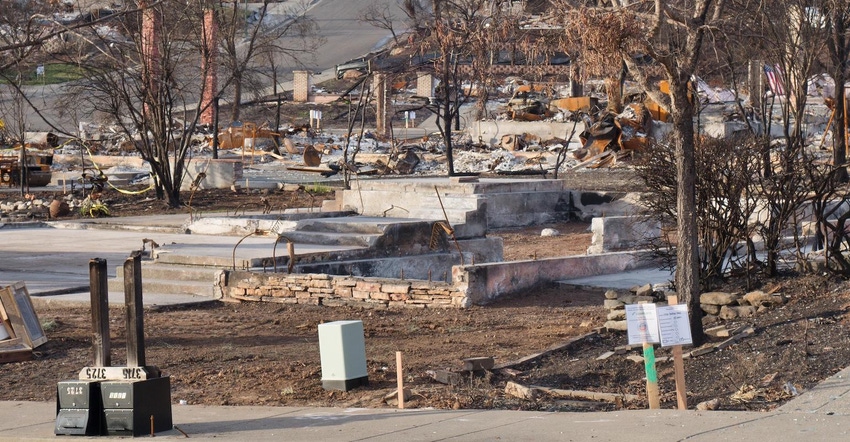Here’s what to look for if you’re inspecting a foundation that has suffered extreme temperatures, according to a concrete science expert.

The Tubbs Fire in 2017 burned over 5,000 structures as it traveled across drought-stricken hillsides in Northern California, torching nearly everything that stood in its way.
The fire was hot enough, and burned long enough, to destroy some concrete foundations, according to Ashok Kakade, a principal engineer with Concrete Science Inc., a company that specializes in condition assessment of concrete structures.
As the fires were still smoldering, Kakade said, a main concern became whether to replace or repair concrete foundations. He shared some of his experiences at a recent American Concrete Institute mini session titled “Condition Assessment of Fire-Damaged Residential Concrete Foundations” at the organization’s recent convention in San Francisco.
“We had to come up with investigative testing to see if (the foundations) were capable of staying in place,” he said. “Because of the sheer number of homes that needed investigation, we divided them into preliminary investigations and detail investigations.”
He said several variables played into how much damage a foundation suffered, including how long concrete was exposed to smoldering debris and whether water was used to suppress the fire.
“Not every home had the same kind of issues,” he said.
In the Tubbs Fire, which devastated areas in and around Santa Rosa, Kakade said firefighters were overwhelmed, causing many structures to be left to burn. He said many buildings burned within 10 minutes, leaving only their foundations.
“The foundation replacement cost was extraordinarily high, so everyone we met and visited said ‘save my foundation,’” he said.
Home concrete foundation replacements often cost more than $250,000, Kakade said. Therefore, in the aftermath of fire, it’s critical to assess them.
How fire damages concrete
When concrete reaches a temperature of around 250° F, the material begins losing moisture, but there is no substantial change in its matrix.
According to the U.S. Department of Agriculture, forest fires can burn at temperatures exceeding 2,000° F, or one-fifth the temperature of the surface of the sun.
“When it exceeds 250° and is in the range of 500° F, things start to change,” he said. “The concrete loses some free moisture. The base volume begins to shrink because (the concrete) loses water, and cracks begin to develop on the surface.”
Kakade said a reduction in compressive strength can accelerate as temperatures rise. He said 1,100° F is a “landmark number” where there is a large change in concrete. “The differential expansion between the cement paste and aggregates and reinforcement starts to cause a lot of cracking,” he said.
After being exposed to temperatures exceeding 1,100° F the material can acquire a white, pink or gray color, which often indicates extensive fire damage.
“That’s the temperature where the concrete chemistry starts changing and the calcium hydroxide starts dehydration,” he said.
Kakade said the preliminary investigations after the Tubbs Fire were mostly visual inspections involving hammering away at the foundation’s surface to see how much of it was worth saving.
“For many homeowners we had to flatly say forget the investigation and replace it because there is no way we can justify the cost of investigating,” he said, adding that shallower foundations were more likely to be declared a total loss.
What to look for
Kakade said hammer testing, the method of simply tapping a hammer on the concrete to see how it sounds, could reveal areas of a foundation that had been damaged but would say little about the material’s remaining compressive strength.
If you don’t see a pinkish color associated with concrete that’s been exposed to fire, that doesn’t mean it isn’t damaged, according to Kakade, adding conversely, pink doesn’t indicate a total loss.
“Even though it is pink, the concrete is deteriorating only on the surface,” he said.
Kakade said it’s critical to find out how deep fire has penetrated the concrete surface, which many times involves chipping away with a hammer to see the true depth of the damage.
Concrete that is destroyed by fire will become brittle. Compressive strength tests from foundations that were exposed to the Tubbs Fire revealed that concrete can lose 80% of its compressive strength after being exposed to extreme temperatures, he said.
About the Author(s)
You May Also Like




